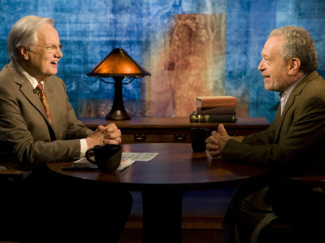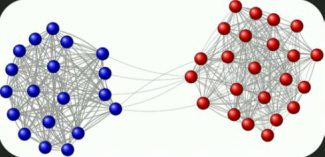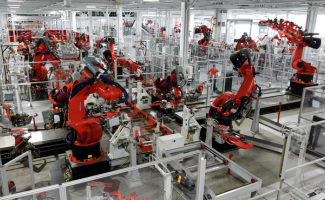 Robert Reich discusses economic inequality with Bill Moyers Robert Reich discusses economic inequality with Bill Moyers Tags: capitalism, class, consumption/consumerism, corporations, crime/law/deviance, economic sociology, globalization, government/the state, inequality, organizations/occupations/work, political economy, politics/election/voting, science/technology, robert reich, social mobility, subtitles/CC, 21 to 60 mins Year: 2013 Length: 56:46 Access: Moyers & Company Summary: In this interview on Moyers & Company, former Secretary of Labor and professor of public policy at the University of California in Berkeley, Robert Reich discusses economic inequality and the worrisome connection between money and political power. Reich notes that "Of all developed nations, the US has the most unequal distribution of income," but US society has not always been so unequal. At about the 6:20 mark, the clip features an animated scene from Reich's upcoming documentary, Inequality for All, which illustrates that in 1978 an average male worker could expect to earn $48,302, while an average person in the top 1% earned $393,682. By 2010, however, an average worker was only earning $33,751, while the average person in the top 1% earned $1,101,089. Wealth disparities have also been growing, and here Reich explains that the richest 400 Americans now have more wealth than the bottom 150 million Americans. What happened in the late 1970s to account for the current trend of widening inequality? According to Reich, there are four culprits. First (at about 19:10 min), a powerful corporate lobbying machine has successfully lobbied for laws and policies that have allowed for wealthy people to become even more wealthy, often at the expense of the poor. Examples include changes to antitrust, bankruptcy, and tax legislation. Second (at 34:00 min), Reich argues that unions and popular labor movements have been on the decline, which means employers have been under less pressure to increase wages over time. Third (at 38:30 min), while globalization hasn't reduced the number of jobs in the US, it has meant that employers often have access to cheaper labor, which has had the effect of driving down wages for American workers. He points out that in the 1970s, meat packers were paid $40,599 each year. Now they only earn $24,190. Fourth (at 38:30 min), technological changes, such as automation, have had the effect of keeping wages low. He concludes that there is neither equality of opportunity nor equality of outcome in the U.S., and unless big money can be separated from politics, the U.S. economy is unlikely to free itself from this viscous cycle of widening inequality for all (Note that a much shorter video featuring Reich's basic argument is also located on The Sociological Cinema). Submitted By: Lester Andrist
2 Comments
 Doubt shapes discourses of science and power. Doubt shapes discourses of science and power. Tags: discourse/language, environment, foucault, health/medicine, knowledge, science/technology, social construction, climate change, creationism, evolution, tobacco, 00 to 05 mins Year: 2012 Length: 5:12 Access: YouTube Summary: This video from The Climate Reality Project entitled "Doubt" illustrates how knowledge and power are tightly interwoven. Using two case studies—the "tobacco is good for you campaign" and the "climate change denial movement"—the clip depicts how science can be used as a mechanism of legitimation by powerful others in ways that best serves status quo interests. Michel Foucault discussed this phenomenon in his extensive work on how the discourse of science (and knowledge) is also a discourse of power. As illustrated in the video, despite the scientific evidence showing tobacco's deadly effects and climate change's dangerous outcomes, powerful interests suppressed this knowledge by introducing doubt into the discourse around tobacco use and climate change, which they backed up using a discourse of science. These powerful interests created the illusion that a scientific debate was taking place when, in reality, there wasn't. An iteration of this phenomenon recently unfolded in the media-hyped debate between Bill "the Science Guy" Nye and creationist Ken Ham. Here, the case of evolution was presented as a scientific debate, thereby suggesting that a lack of consensus surrounds the scientific evidence around evolution. This tactic of using a discourse of science to create the illusion of uncertainty around evolution was echoed by Michael Schulson in his article for The Daily Beast, in which he writes: "Ham’s argument, essentially, was that there are two kinds of science—observational, concerned-only-with-what-we-can-touch-and-see science, on which, Ham said, we all happily agree; and historical science, on which we don’t. This is bullshit, of course. We can use evidence from the present to extrapolate about the past." Yet, like the case of tobacco and climate change, by creating doubt about the earth's origins, the public's access to scientific knowledge is suppressed. This video would complement a discussion around the sociology of knowledge, science, and power, and would pair well with portions of the This American Life radio episode, "Fake Science," and with sociologist Zuleyka Zevallos's article, "The Sociology of Why People Don’t Believe Science." Viewers can be encouraged to think about: Whose interests are served in each of the fake science cases of tobacco, climate change, and evolution? What is the role of the media in perpetuating fake science? How has fake science shaped social policy? Other videos from The Climate Change Project can be found here. Submitted By: Valerie Chepp  "The Scarecrow" explores the McDonaldization of society "The Scarecrow" explores the McDonaldization of society
Tags: capitalism, consumption/consumerism, corporations, environment, food/agriculture, marketing/brands, organizations/occupations/work, science/technology, theory, weber, farming, fordism, george ritzer, mcdonalidzation, rationalization, slow food, subtitles/CC, 00 to 05 mins
Year: 2013 Length: 3:23 Access: YouTube Summary: "The Scarecrow" is Chipotle's most recent commercial exploring the American dependency on highly rationalized farming techniques, which offend human conscience and wreak havoc on the environment (Note that Chipotle created a commercial with similar themes back in 2011). This animated short takes place in a dystopian universe where scarecrows punch in each day at a factory run by their crow overlords, and crow surveillance drones caw whenever production slows. The video is a useful illustration of what George Ritzer has called the McDonaldization of society, which refers to "the process by which the principles of the fast-food restaurant are coming to dominate more and more sectors of American society." Ritzer explains that McDonaldization is characterized by efficiency, calculability, predictability, and control. In and around the barren landscape owned by Crow Foods, one finds examples of efficiency everywhere. Conveyer belts efficiently move workers to their various stations in the factory, and livestock are stacked in crates, one on top of the other—an efficient use of factory space. Scanning the inner workings of the factory, it appears that ground beef, chicken, and pork are being squeezed through narrow chutes, and large blades worthy of a guillotine slice the meats into slabs with such precision that one could easily calculate and predict the amount of meat produced in any given hour. Controlling the pace of production is as easy as pulling a lever. While the video is quite literally Chipotle's straw man fantasy and is created with the aim of developing the Chipotle brand as a healthy, environmentally-friendly meal choice, the McDonaldization of food production is a very real phenomena and one sociologists take very seriously (The Sociological Cinema has also explored the issue here and here). What could be more important than understanding how a system, which was ostensibly developed to nourish vast numbers of people, is actually harmful to human health? Submitted By: Lester Andrist  The complex social network of a bat colony The complex social network of a bat colony Tags: biology, science/technology, animals, society, 11 to 20 mins Year: 2013 Length: 13:45 Access: TED Talks Summary: In this TED talk, Nicolas Perony shows how animal groups have many interacting parts that follow simple individual rules to make up complex societies. He works through examples of dogs humorously moving synchronously, the social network dynamics of bat colonies, and how subordinate and dominant meerkats interact to successfully navigate risky physical space (see also this NYT video on "elephant empathy"). His talk first illustrates an important feature of society: the whole is greater than the sum of its parts. By working together, individual animals maintain stable social structures that meet the needs of the community and can help a species’ adaptability to their environment. The animals are highly dependent on one another for survival, and often adopt distinct behaviors that enable them to contribute to the whole. The second point is cautionary and comes at the very end of the video. When Perony concludes his presentation, the host joins him on stage and asks him: “Is it okay to do these associations [between animals and humans]? Are there stereotypes … that can be valid across all species?” Perony deftly responds that “there are also counter-examples to these stereotypes. For example, in the seahorses and koalas, these are males that take care of the young—always. The lesson is that it’s often difficult and sometimes dangerous to draw parallels between humans and animals.” Viewers might be urged to consider why such parallels are dangerous. For example, these arguments are often evoked to justify inequalities (e.g. that males dominate women within society, or with the pseudo-science of eugenics), although such parallels have also been used to legitimate equality and social solidarity in human societies (see Wilkinson and Pickett’s The Spirit Level, especially chapter 14). Submitted By: Paul Dean  Drones will be big business, but raise privacy concerns. Drones will be big business, but raise privacy concerns. Tags: crime/law/deviance, foucault, government/the state, science/technology, theory, war/military, drones, panopticon, surveillance, unmanned aerial vehicles, 00 to 05 mins Year: 2013 Length: 4:41 Access: New York Times Summary: Unmanned aerial vehicles (UAVs), or drones, are the "future of aviation." The Federal Aviation Administration (FAA), which regulates the use of drones and currently limits the commercial use of drones in the US, is likely to loosen this restriction by 2015 and private industry is positioning itself for a commercial boom in drones. And while the US government has mostly used drones for surveillance and combat in the war on terror, the government has weighed the use of drones for surveilling its own citizens. As noted by the NYT, Senator Patrick Leahy, a Vermont Democrat and chairman of the Senate Judiciary Committee, said this year: “This fast-emerging technology is cheap and could pose a significant threat to the privacy and civil liberties of millions of Americans. It is another example of a fast-changing policy area on which we need to focus to make sure that modern technology is not used to erode Americans’ right to privacy.” From a Foucauldian perspective, the possibility of widespread drone surveillance could be the new Panopticon. In particular, inexpensive drones (<$1000) allow for continuous video footage, facilitating the proliferation of micro-power as individuals, corporations, and government observe others throughout all of society. Furthermore, it is likely to spread throughout a variety of institutions, enabling the use of drone surveillance in search-and-rescue missions, agricultural surveillance, and countless other personal and commercial applications. While Foucault offered the metaphor of surveillance technologies as swarming throughout society, drones offer a very literal extension of this expanding technology. Submitted By: Paul Dean  Eugenic thinking is woven into the fabric of American society Eugenic thinking is woven into the fabric of American society Tags: biology, bodies, class, crime/law/deviance, demography/population, disability, discourse/language, gender, health/medicine, immigration/citizenship, intersectionality, lgbtq, nationalism, prejudice/discrimination, race/ethnicity, science/technology, sex/sexuality, institutionalized discrimination, eugenics, subtitles/CC, 11 to 20 mins, 21 to 60 mins Year: 2012; 2013 Length: 15:05; 17:25 Access: YouTube (clip 1; clip 2) Summary: The eugenics movement has a long history in the United States. A popular misconception is that eugenic thinking and the associated practices were uniformly abandoned after the Third Reich's genocidal intentions were laid bare at the end of the Second World War. In point of fact, eugenic ideologies and practices have been recalcitrant features of American social institutions right up until the present day. In her book American Eugenics: Race, Queer Anatomy, and the Science of Nationalism, Nancy Ordover remarks on the resiliency of the ideology, "Eugenics..is a scavenger ideology, exploiting and reinforcing anxieties over race, gender, sexuality, and class and bringing them into the service of nationalism, white supremacy, and heterosexism." In earlier decades eugenicists could openly discuss stemming the "overflow" of immigration, as an effort to "dry up...the streams that feed the torrent of defective and degenerate protoplasm." The language of eugenics would eventually change, but the core ideas have remained; socially deviant groups and socially undesirable conditions are seen by eugenicists as biologically determined. The above clips are news stories, which draw attention to two recent manifestations of eugenics policy. The first clip chronicles the experience of an African American woman who was legally sterilized in the late 1960s in North Carolina after giving birth to her first son. The clip reports that between 1929 and 1974 approximately 7,600 North Carolinians were sterilized for a host of dubious reasons, from "feeble-mindedness" to "promiscuity." But while North Carolina's victims included men, women, and children, Ordover's research points out that the victims were overwhelmingly women and African American (by 1964 African Americans composed 65% of all women sterilized in the state). The first clip, then, is an example of how eugenics became institutionalized with the force of law, but the second news clip examines a case of institutionalized eugenics in California, which existed without the explicit consent of law. In 1909 California became the third state to pass a compulsory sterilization law, allowing prisons and other institutions to sterilize "moral degenerates" and "sexual perverts showing hereditary degeneracy." By 1979, when the law was finally repealed, the state had already sterilized as many as 20,000 people, or about one-third of the total number of such victims throughout the United States. One learns from the news clip that between 2006 and 2010, 148 women were sterilized by doctors who continued to be guided by the precepts of their eugenic ideology. Submitted By: Lester Andrist  GoldieBlox wants to inspire girls to become engineers GoldieBlox wants to inspire girls to become engineers Tags: children/youth, gender, marketing/brands, organizations/occupations/work, science/technology, occupational sex segregation, socialization, stem fields, subtitles/CC, 00 to 05 mins Year: 2013 Length: 2:06 Access: Slate; YouTube Summary: This new commercial from the GoldieBlox toy company has been enthusiastically shared among feminists and those who are generally frustrated by the dearth of creative toys for girls. The ad features three bored little girls watching a generic television ad of other girls dressed in princess costumes. The three girls throw on a record of a reworked Beastie Boys tune, they grab their tools, and in the next shot, we see that they have constructed an elaborate Rube Goldberg apparatus. Swinging levers beget cascading dominoes and rolling bowling balls, until at last a makeshift hammer swings toward the television and appears to change the channel. The ad is in keeping with GoldieBlox's overall mission, which is to "show the world that girls deserve more choices than dolls and princesses [and that] femininity is strong and girls will build the future." The company's concern is well placed too. In the United States, between 2000 and 2009, the percentage of women in the field of engineering has been in decline, and currently, only about 18% of all engineering degree holders are women (According to GoldieBlox, only 11% of total engineers worldwide are women). Obviously the commercial seeks to sell toys, but it might work well as a means to draw attention to this gendered imbalance in the field of engineering (i.e., occupational sex segregation), and how this imbalance is connected to the different ways boys and girls are socialized. But one can take the analysis even further. Notice that even in this fairly progressive ad, gender proves itself as a resilient basis upon which to socialize boys and girls differently. For all GoldieBlox's talk on their website about "disrupting the pink aisle," it is important not to lose sight of the fact that the company's marketing approach actually reinforces the gender binary just as well as any other company's. GoldieBlox might be disrupting pink as an innately feminine color, but it leaves unscathed the core idea that girls and women are somehow fundamentally different than boys and men. Submitted By: Lester Andrist  Tags: culture, education, science/technology, social mvmts/social change/resistance, cultural lag, material culture, nonmaterial culture, popular culture, social change, symbolic culture, 00 to 05 mins Year: 1993 Length: 3:32 Access: YouTube Summary: In 1993 and 1994, AT&T released a series of commercials depicting a host of cutting edge technologies. In one commercial a man relaxes on a beach holding what appears to be a tablet computer: "Have you ever sent a fax from the beach?" comes the voiceover. "You will." This ad campaign might be useful for instructors seeking to illustrate the distinction between two aspects of any culture: material and nonmaterial. Nonmaterial culture refers to things like values, norms, and social roles, while material culture refers to the physical artifacts of a culture and typically includes the sorts of things people can touch. When a person asserts that hamburgers are a part of American culture, they are really referring to material culture. Tablets and cell phones too are manifestations of material culture. Most of the twenty or so innovative products depicted in AT&T's "You will" ad campaign have long since faded into the vast tableau of consumers' technologically augmented lives, but with the benefit of hindsight, it's possible to draw on the commercials to reflect on how technology has changed the lives of average people. To put it differently, how do changes in material culture give rise to changes in nonmaterial culture? For instance, to the extent that technological advances are driving the growth of massive open online courses (MOOCs), what kinds of changes in the nonmaterial aspects of higher education will likely follow suit? How are the norms, values, and roles usually associated with educational institutions being permanently altered? Finally, while it may seem apparent that technological changes in material culture drive changes in nonmaterial culture, is the reverse ever true? Do changes in norms, values, and roles give rise to changes in technology? Submitted By: Steven Dashiell  Stephen Colbert Tags: methodology/statistics, science/technology, depression, research methods, validity, 00 to 05 mins Year: 2011 Length: 2:22 Access: The Colbert Report Summary: In this clip, Stephen Colbert critiques a research study that claims late night television causes depression. Methodologically, Colbert first points out rather than having humans watch late night television and then assessing levels of depression, the scientists exposed hamsters to dim lighting at night and then examined the rodents' brains and behaviors. Thus, despite headlines promoting the link between television and depression, all the scientists actually discovered is that low light affects hamsters. After revealing this methodological weakness, Colbert puts human viewers at ease by letting us know that people are immune to his underhanded plot to drive hamsters to suicide. Thus inadvertently, Colbert reveals the importance of validity to scientific methodology. We must always be careful what findings we extrapolate from studies by asking ourselves, does this study actually measure what it is supposed to measure? Submitted By: Jason T. Eastman  A factory run by robots in Fremont, CA. Tags: capitalism, economic sociology, globalization, marx/marxism, organizations/occupations/work, science/technology, theory, assembly line, deskilling, jobs, labor, reskilling, robotics, 00 to 05 mins Length: 3:58 Year: 2012 Access: New York Times Summary: This NYT video examines innovations in robot technology used for factory production (see associated article). These robots are far more sophisticated than typical factory robots, and they have important implications for work, labor, and the geography of the global economy. As Marx predicted, global competition drives producers to mechanize their operations to drive down costs. For example, as the article notes, "In one example, a robotic manufacturing system initially cost $250,000 and replaced two machine operators, each earning $50,000 a year. Over the 15-year life of the system, the machines yielded $3.5 million in labor and productivity savings." The robots are replacing huge numbers of low and mid-skilled workers, making assembly lines more efficient and creating some higher skilled jobs. At 2:50, a representative from a robotics company states "We don't view robots as a way to eliminate the labor, it's just an opportunity to raise that skill set and help everybody realize a better life as a result of that, get them out of that repetition and into a place where they can earn a higher wage and be more successful." Viewers may reflect on this highly optimistic view. In some cases, these advanced technologies are bringing manufacturing jobs now held in countries like China back into the US. With the automation of much manual labor, the new jobs are often safer - but they also have new forms of stress and higher insecurity. However, many people who lose their jobs do not have access to the education and training needed to reskill themselves for the new jobs. Furthermore, such technologies might lead to the increasing polarization of jobs in terms of both skills and wages. Who wins and who loses when robots replace human labor? Image by Paul Sakuma/Associated Press Submitted By: Paul Dean |
Tags
All
.
Got any videos?
Are you finding useful videos for your classes? Do you have good videos you use in your own classes? Please consider submitting your videos here and helping us build our database!
|
 RSS Feed
RSS Feed
